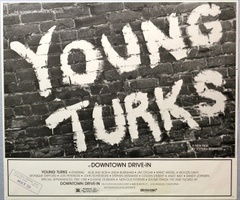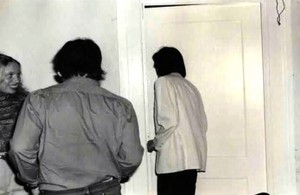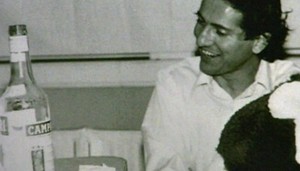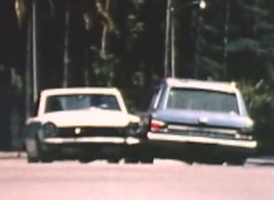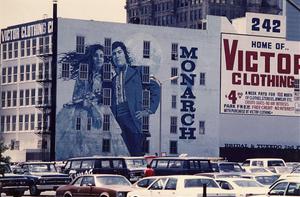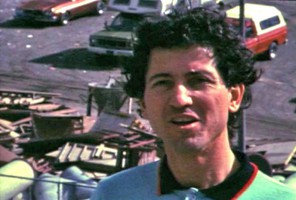

Richard Newton: The Missing Turk
'Get Under the Table, Don't Look at the Windows'
When Stephen Seemayer projected a rough cut of "Young Turks" against a downtown warehouse wall in 1981, Richard Newton was not among the artists included in the film.
Seemayer and Newton had been very good friends and collaborators on several videos — including "A Glancing Blow," in which Seemayer was a cameraman in one of the cars. Seemayer had filmed Newton doing performances and talking about his work, just as he had the other downtown artists that he was friends with in those days. Seemayer had even assemble-edited Newton's section of the film, which included Newton taking viewers on "the first tour" of the as-yet-unbuilt Museum of Contemporary Art on Bunker Hill.
But for one reason or another — the two friends still cannot agree on what went wrong — Seemayer left Newton's footage on the cutting room floor when he put together the first rough cut for the 1981 screening.
When Seemayer and editor Pamela Wilson decided to reenvision "Young Turks" in 2012, they agreed the section was worth reviving and added it back into the finished film.
In "Young Turks," Newton explains some of the ideas behind his performances of the late 1970s and early 1980s, in which he inhabited hotel rooms for an extended period and the audience observed through cracked doors and windows what he was doing inside.
"If we're artists," Newton explains, "we might think that, somehow, we're doing something special that's different from what the rest of the people are doing, either the people working, or the people just living on the street.
"But in fact, we're doing kind of the same thing. We're in a pattern. We make our art, we go through certain rituals. We have certain things we have to do to survive."
In "Get Under the Table, Don't Look at the Windows" — a 1980 performance at the Hotel El Dorado on Spring Street — Newton inhabited a room of what was then a rundown flophouse and explored alcoholism and fears of nuclear annihilation in conversations with stuffed animals that were observed by the audience through a crack in the room's chain-secured door.
"When I'm in that room," Newton says in "Young Turks," "the kind of activity I'm involved in is the same kind activity that a child would be involved in, that an adult who's living in that hotel would be involved in, and that an artist would be involved in, staying in their own studio and working on their own."
Newton has never ceased making art. He continues to create films and performances in his Pasadena, CA, studio.
Newton the Nomad
In "Young Turks," performance artist Richard Newton memorably takes viewers on the "first tour of the Museum of Contemporary Art" on Bunker Hill.
During the shooting of "Young Turks" in 1977-1981, filmmaker Stephen Seemayer and Newton lived downtown and collaborated on each other's projects. (Seemayer is driving one of the cars in Newton's film/performance "A Glancing Blow," a portion of which is included in "Young Turks.")
Newton had a studio at the Victor Clothing Building for a few years, and later he had the top floor of a building at 8th and Spring streets. But apparently, after an unstable childhood, he has never really felt settled.
In the Laguna Beach Coastline Pilot, journalist Rhea Mahbubani paints a touchingly intimate portrait of Newton, the performance artist/filmmaker/gadabout.
"Just like I move around a lot, I change my name a lot," said Newton, who donned the pseudonym Ric Marin upon embarking on his career as an artist. "So besides the fact that I don't seem to know where I belong, I also actually don't know what my name is. Fortunately, I guess I have art to attach all this stuff to."
"Ultimately," Mahbubani concludes, "Newton's every venture is driven by a desire to communicate."
"What I enjoy the most is when viewers — across a broad spectrum of ages and backgrounds — somehow find something in what I have done to relate to themselves," he said. "I want them to be able to step in and feel something."
